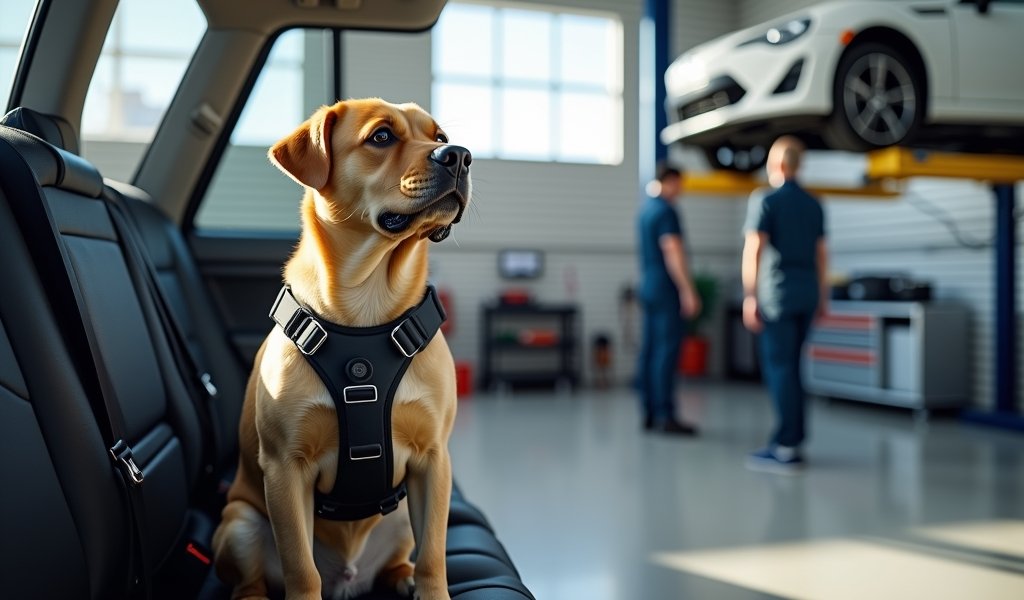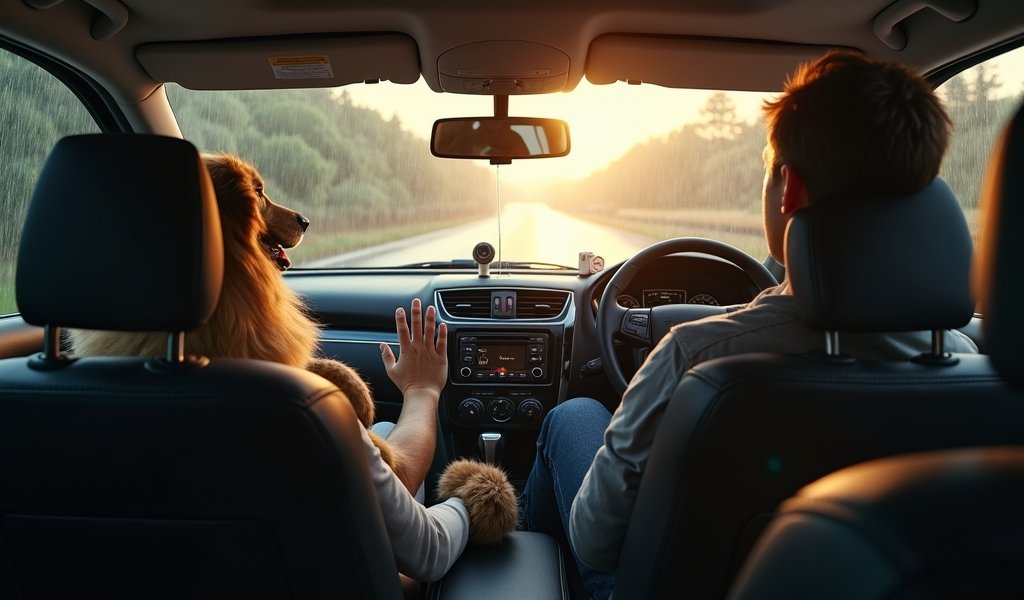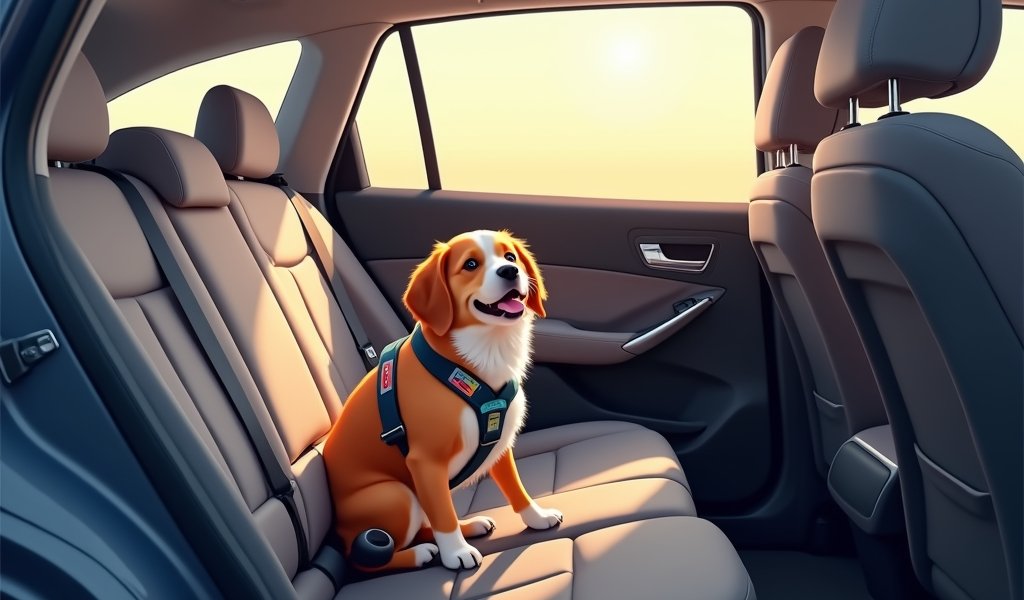Overview
This article emphasizes the critical importance of dog car harnesses for safety during travel, comparing five top models (Sleepypod Clickit Sport, Kurgo Tru-Fit, Ruffwear Load Up, EzyDog Drive, and Petafe Chewsafe) while providing guidance on proper fitting, dog training techniques, and legal considerations. Beyond preventing injury in accidents, proper restraints reduce driver distraction, may satisfy legal requirements in certain states, and demonstrate responsible pet ownership.
Table of Contents
- Why Dog Car Harnesses Matter: Safety First
- Choosing the Right Harness: Key Features to Consider
- Top 5 Dog Car Harnesses for 2023
- Proper Fitting: Getting It Right Every Time
- Training Your Dog to Love Their Car Harness
- Legal Requirements: What You Need to Know
- Conclusion
- Frequently Asked Questions
Why Dog Car Harnesses Matter: Safety First
Picture this: you’re cruising down the highway, wind in your hair, your furry best friend sitting happily in the passenger seat. Suddenly, you need to slam on the brakes. In that split second, your 60-pound companion becomes a 2,700-pound projectile. That’s the physics of a collision at just 35 mph. Sobering, isn’t it?
Dog car harnesses aren’t just fancy accessories – they’re lifesavers. Like the seatbelts we don’t think twice about buckling, these specialized restraints keep our four-legged family members secure during sudden stops, sharp turns, and heaven forbid, accidents. But the safety benefits extend beyond your pup.
An unrestrained dog is a distraction that rivals texting while driving. Those adorable antics? They pull your eyes from the road for precious seconds. According to a study published in Accident Analysis & Prevention, driving with an unrestrained pet increases your risk of being in a crash significantly. When properly secured in a quality dog car harness, your pup stays in place, allowing you to keep your attention where it belongs – on the road ahead.
But not all dog car harnesses are created equal. Just as you wouldn’t trust your child to a bargain-bin carseat, your dog deserves protection that’s been rigorously tested and proven effective. The difference between a proper safety harness and a basic restraint could literally be life or death in a serious collision.
With pet car safety becoming increasingly important to responsible pet parents, manufacturers have stepped up with innovative designs that balance security with comfort. After all, what good is a harness if your dog is too uncomfortable to wear it?
Choosing the Right Harness: Key Features to Consider
Shopping for a dog car harness can feel like navigating a labyrinth of technical terms and marketing promises. Let’s cut through the noise and focus on what really matters: the features that separate the best from the rest.
First and foremost, crash-test certification should be at the top of your checklist. The Center for Pet Safety (CPS) puts harnesses through rigorous testing using specially designed dog dummies. A CPS certification is the gold standard, indicating the harness has been tested to withstand the forces of a collision.
Material quality speaks volumes about durability and safety. Premium harnesses feature heavy-duty nylon webbing, reinforced stitching at stress points, and metal hardware instead of plastic. These materials might add a few dollars to the price tag, but they’re worth every penny when it comes to withstanding the tremendous forces of a sudden stop.
Size and fit customization is non-negotiable. Dogs come in all shapes and sizes – from Chihuahuas to Great Danes – and their harnesses should reflect this diversity. Look for multiple adjustment points that allow for a snug (but not restrictive) fit across the chest and shoulders. Remember, a properly fitted harness distributes crash forces across the strongest parts of your dog’s body.
Comfort features might seem secondary to safety, but they’re crucial for compliance. Padded chest plates, breathable mesh panels, and freedom of movement encourage your dog to accept the harness as part of the travel routine. After all, the safest harness in the world won’t help if your dog refuses to wear it.
Ease of use matters more than you might think. In the hustle of daily life, complicated harness systems often end up unused. The best designs balance security with straightforward application – look for simple click-in mechanisms and intuitive adjustment systems that don’t require an engineering degree to operate.
Lastly, consider versatility. Some premium harnesses double as walking harnesses, eliminating the need to switch gear when you reach your destination. This two-in-one functionality is especially valuable for road trips where you’ll be making multiple stops.

Top 5 Dog Car Harnesses for 2023
1. Sleepypod Clickit Sport
The Sleepypod Clickit Sport stands tall as the heavyweight champion of dog car harnesses. It’s not just CPS certified – it aced their tests with flying colors. The ingenious three-point design works similarly to human seatbelts, distributing crash forces across the dog’s chest and upper torso rather than concentrating on the vulnerable neck area.
What sets the Clickit Sport apart is its infinitely adjustable design that creates a truly custom fit for dogs of various builds. The padded vest-style construction cradles your dog comfortably, while reflective strips add visibility during nighttime rest stops. Yes, it comes with a premium price tag (typically $75-$95 depending on size), but can you really put a price on peace of mind?
Perfect for: Medium to large dogs who travel frequently, especially those with owners who prioritize proven crash protection above all else.
2. Kurgo Tru-Fit Enhanced Strength Harness
The Kurgo Tru-Fit strikes that delicate balance between affordability and safety that many pet parents are searching for. While not CPS certified, it’s been crash-tested in facilities using standards similar to those for child safety restraints. The five adjustment points allow for a remarkably precise fit, while the padded chest plate cushions against sudden stops.
What truly distinguishes the Kurgo is its versatility. The included carabiner attachment makes it a seamless walking harness when you reach your destination – no more struggling to switch gear with an excited dog bouncing around the parking lot. At roughly $35-$45, it offers serious bang for your buck without cutting corners on essential safety features.
Perfect for: Budget-conscious pet parents who need a reliable dual-purpose harness for occasional travel with small to medium dogs.
3. Ruffwear Load Up Harness
Designed specifically for the rigors of travel, the Ruffwear Load Up harness has established itself as the adventure dog’s best friend. This harness undergoes testing at the same facility that certifies child safety seats, and the quality is immediately apparent in its construction. The aluminum hardware and reinforced webbing inspire confidence, while the padded structure ensures your dog remains comfortable on long journeys.
What outdoor enthusiasts particularly appreciate is the harness’s ability to allow dogs to sit, stand or lie down comfortably while remaining securely tethered. The thoughtfully designed structure keeps pressure off the trachea even during sudden stops. Priced around $80, it’s an investment in both safety and comfort for dogs who regularly accompany their humans on road trips and outdoor adventures.
Perfect for: Active dogs who frequently travel to outdoor destinations and need a harness that can handle rough terrain once you arrive.
4. EzyDog Drive Safety Travel Dog Car Harness
The EzyDog Drive harness approaches vehicle safety with an innovative perspective. Its standout feature is the Mag-Lok instant fit closure system, which dramatically simplifies the often frustrating process of harnessing an excited dog. Once fitted properly the first time, subsequent applications require just a quick magnetic snap – perfect for dogs who get antsy during pre-travel preparations.
EzyDog hasn’t sacrificed safety for convenience, though. The harness features a broad, padded chest plate that disperses energy across the strongest parts of your dog’s body. The tri-glide adjustment system ensures the perfect fit for dogs of various shapes within each size category. At approximately $65-$75, it represents the perfect middle ground between premium protection and practical design.
Perfect for: Impatient dogs who hate standing still for harness adjustments, and owners who value quick, fuss-free departures.
5. Petafe Chewsafe Dog Car Harness
Some dogs see restraints as chew toys on a personal mission to destroy them. Enter the Petafe Chewsafe – designed specifically for the Houdinis and demolition experts of the dog world. Constructed with chew-resistant materials similar to those used in protective police gear, this harness stands up to determined gnawers without compromising safety.
Beyond its durability, the Chewsafe incorporates smart safety features like energy-absorbing padding and reinforced stitching at key stress points. The four-point adjustment system accommodates dogs with unique proportions that might struggle with less adaptable designs. At around $55-$65, it’s a worthy investment for pet parents who’ve already witnessed their determined chewers destroy lesser products.
Perfect for: The escape artists and dedicated chewers who have made short work of standard harnesses in the past.
Proper Fitting: Getting It Right Every Time
A top-tier dog car harness becomes dangerously ineffective if it’s not fitted correctly. Think of it like a helmet worn incorrectly – it creates a false sense of security while offering little actual protection. Let’s break down the fitting process into manageable steps that ensure your four-legged friend gets maximum protection.
Start by measuring your dog accurately. Most harnesses require two key measurements: chest girth (measured at the widest part of the chest, usually just behind the front legs) and neck circumference. Use a soft measuring tape and add two fingers of space for comfort. Remember that each manufacturer has slightly different sizing charts – don’t assume your dog is the same size across different brands.
The two-finger rule is your best friend when checking the fit. Slip two fingers between the harness and your dog’s body at various points – this provides enough room for comfort without creating dangerous slack. Pay special attention to the chest strap, as this bears the brunt of force during a sudden stop.
Watch for these red flags that signal a poor fit:
- Harness shifts significantly when your dog moves
- Dog can back out of the harness when slight pressure is applied
- Straps twist or fold rather than lying flat
- Chest plate rides up toward the neck instead of staying on the sternum
- Signs of discomfort like excessive panting, reluctance to move, or trying to paw at the harness
Adjustment points are there for a reason – use them! Many owners adjust a harness once and consider it done, but seasonal coat changes and weight fluctuations mean regular reassessment is necessary. Mark your calendar for monthly fit checks, especially after grooming sessions for long-haired breeds.
If you’re unsure about the fit, many pet car accessories retailers offer virtual fitting services where you can send photos or video for professional assessment. This extra step might seem excessive, but considering what’s at stake, it’s time well spent.
Training Your Dog to Love Their Car Harness
Even the safest, most perfectly fitted harness is useless if your dog refuses to wear it. Like introducing any new equipment, successful harness training requires patience, positive association, and consistent practice. Let’s explore how to turn that “what is this contraption?” look into tail-wagging enthusiasm.
First impressions matter tremendously. Rather than immediately strapping your dog into the harness and heading for the car, introduce it gradually in a positive environment. Let your dog sniff and investigate the harness while you offer praise and treats. This creates a foundation of curiosity rather than suspicion.
Once your dog seems comfortable around the harness, begin the association game. Place treats inside or on top of the harness, encouraging your dog to interact with it voluntarily. Practice holding the harness open near your dog without actually putting it on, offering rewards for calm behavior. This builds a positive emotional response before you even begin the fitting process.
When it’s time for the first fitting, choose a moment when your dog is relaxed – not right before an exciting walk or when they’re bursting with energy. Keep the first session brief – perhaps just putting the harness on, offering abundant praise and treats, then removing it after a minute or two. Gradually extend wearing time during subsequent sessions.
Short practice runs make all the difference. Once your dog accepts wearing the harness at home, progress to wearing it during brief car trips to enjoyable destinations like parks or friends’ homes. This teaches your dog that the harness predicts fun adventures, not just veterinary visits.
For particularly resistant dogs, try these troubleshooting techniques:
- Use high-value treats reserved exclusively for harness training
- Practice at meal times when motivation is highest
- Consider anxiety-reducing products like calming sprays on the harness
- Enlist a second person to distract with treats while you handle the harness
- Break the process into smaller steps if your dog seems overwhelmed
Remember that consistency beats intensity every time. Five minutes of positive practice daily yields better results than occasional hour-long sessions that leave both you and your dog frustrated.

Legal Requirements: What You Need to Know
The legal landscape regarding dog restraints in vehicles resembles a patchwork quilt across the United States. While some states have implemented specific laws, others rely on broader distracted driving or animal cruelty statutes that could potentially apply to unrestrained pets. Navigating these varying requirements can be confusing, but ignorance of the law won’t protect you from citations or liability.
Currently, states like New Jersey, Rhode Island, and Hawaii have the most explicit laws regarding dog restraints in vehicles. New Jersey’s law, often considered the strictest, can result in fines between $250-$1,000 and potential animal cruelty charges for driving with unrestrained pets. In contrast, many states address the issue indirectly through distracted driving laws that could be applied if your unrestrained dog causes you to drive erratically.
Beyond avoiding tickets, proper restraint directly impacts liability in accidents. If your unrestrained dog contributes to causing an accident, insurance companies may deny claims or reduce payouts, leaving you financially vulnerable. Additionally, some insurance providers offer discounts for using approved pet restraint systems, recognizing their role in accident prevention.
The legal considerations extend beyond personal vehicles. If you frequently use rideshare services or rentals with your dog, be aware that many companies have specific policies requiring pet restraints. Violating these policies could result in service denial or additional cleaning fees if your unrestrained pet damages the vehicle.
Perhaps most compelling is the potential for legal liability if your unrestrained dog injures another person during an accident. Courts increasingly recognize owner responsibility for preventable injuries caused by pets, and medical expenses for injured parties could far exceed any insurance coverage you might have.
Even in areas without specific restraint laws, using a quality car pet barrier or harness demonstrates responsible ownership and could be the deciding factor in avoiding citations under more general safety statutes. The legal landscape continues to evolve as more jurisdictions recognize the safety implications of unrestrained pets in vehicles.
Conclusion
When it comes to traveling with our four-legged companions, a quality dog car harness isn’t just an accessory—it’s an essential safety device that could save lives. Like choosing the right car seat for a child, selecting and properly using the appropriate harness for your dog demonstrates the care and responsibility that defines true pet parenthood.
The five harnesses we’ve explored—Sleepypod Clickit Sport, Kurgo Tru-Fit, Ruffwear Load Up, EzyDog Drive, and Petafe Chewsafe—each offer unique advantages for different dogs and situations. Whether you prioritize crash-test certification, ease of use, chew resistance, or versatility, there’s a harness designed to meet your specific needs while keeping your furry friend secure.
Remember that even the highest-rated harness only works when it’s properly fitted and consistently used. Take the time to measure your dog accurately, check the fit regularly, and train your pet to accept the harness as part of the travel routine. The small investment in time yields immeasurable returns in safety and peace of mind.
As legal requirements continue to evolve across different jurisdictions, staying ahead of the curve with proper restraints protects not only your pet but also your legal and financial well-being. The potential consequences of traveling with an unrestrained dog—from tickets to liability for accidents—far outweigh the minor inconvenience of using a harness.
What’s your experience with dog car harnesses? Have you tried any of our recommended models, or do you have another favorite? We’d love to hear your stories and insights at KnowsYourCar.com, where our community of pet-loving drivers shares tips and experiences to keep all our furry family members safe on the road.
Frequently Asked Questions
How long can a dog safely wear a car harness?
Most dogs can safely wear a properly fitted car harness for 3-4 hours at a stretch. For longer trips, schedule breaks every few hours to allow your dog to stretch, relieve themselves, and reset their comfort level.
Can puppies use standard dog car harnesses?
Puppies should use harnesses specifically designed for their growing bodies and developing joints. Look for puppy-specific models or wait until they reach the minimum weight requirement (usually 10-15 pounds) for standard harnesses.
How often should I replace my dog’s car harness?
Replace your dog’s car harness every 2-3 years with normal use, or immediately if you notice fraying, damaged stitching, or compromised hardware. Like human seatbelts, harnesses can degrade from UV exposure and regular wear.
Can I wash my dog’s car harness?
Most harnesses can be hand-washed with mild soap and air-dried. Machine washing or drying can damage structural components and compromise safety, so always check the manufacturer’s specific care instructions.
Are dog car harnesses comfortable for long trips?
Quality harnesses designed with padded chest plates and multiple adjustment points can be comfortable for extended periods. The key is proper fit—a well-fitted harness allows your dog to sit, stand, and lie down naturally while remaining secure.

